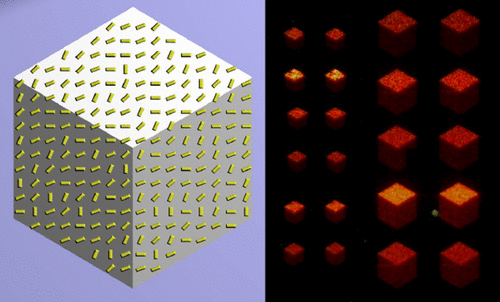Scientists manipulate light to make flat surfaces appear as 3-D objects

Scientists have created new 2-D nanostructured surfaces which appear as realistic 3-D objects – including shading and shadows - using cutting edge nano-engineering.
The research was carried out by King's College London alongside Rheinische Friedrich-Wilhelms-Universität Bonn, and is published in the American Chemical Society journal Nano Letters.
When light hits an object, the colour, texture, and shape affect how light is absorbed and reflected, allowing you to make out the object in front of you. By altering the surface to change how light is reflected, it is possible to manipulate how it appears.
The researchers developed layered materials, incorporating precisely designed nano-features smaller than the wavelength of light, called metasurfaces. This allowed them to control how light is reflected in highly precise ways, so that a 2-D surface reflects light just as a 3-D object would.
Borrowing a technique from 3-D computer graphics called Normal Mapping, researchers encoded shadow effects into the image, creating 3-D images more realistic than holograms or 3-D cinema. As a proof of concept, the researchers fabricated a flat metasurface imitating lighting and shading effects of a 3-D cube.
Changing the way we see light
The technique could have huge implications for the optical industries, including in TV screens and photography, as well as in security labels for protecting goods and banknotes from counterfeiting.
Professor Anatoly Zayats of King's College says: "Metasurfaces are amazing. They open up unprecedented freedom in directing and manipulating light. One might ultimately imagine a TV screen which appears exactly the same as you move around it, or a new movement of 3-D art."
The ability to control light could bring new functionality to small camera lenses. A flat surface can be made to appear optically convex by designing appropriate metasurface properties. Future generations of smartphone cameras could use the tiny flat metasurfaces which mimic the properties of sophisticated curved camera lenses, allowing much greater control of angle and depth field.
Metasurfaces could also replace heavy optical lenses in applications such as satellites, where weight and size have a big impact on efficiency.
More immediately, the novel nano-materials can already be used to create unique complex 3-D images for security and anti-counterfeiting applications, as well as for new measurement applications requiring precise control of light.
Much more than a hologram
Unlike holograms, which require a coherent light source such as a laser to be viewed, these surfaces manipulate the reflection of normal light so they appear as a realistic 3-D object in any light condition and from any angle.
Existing holographic approaches rely on 'specular reflection' ie the light coming from a particular direction is reflected in a unique outgoing direction, as with a mirror. In order to achieve dynamic light shading effects, a metasurface design involves 'diffuse reflection' – which allows control of its scattering properties so that the image can be seen directly on it.
For the proof of concept, the researchers designed a cube using the normal mapping technique, which was encoded into the metasurface. When illuminated, the metasurface instantaneously "computes" how a 3-D representation of the image should look and displays it.
Dr Alexander Minovich, The Royal Society Newton International Fellow at King's College London, said: "The normal mapping demonstrated with our metasurface is a completely new concept, but it could have very important implications for a wide range of optical industries, both in introducing new functionality and making products smaller and lighter."
More information: Alexander E. Minovich et al. Reflective Metasurfaces for Incoherent Light To Bring Computer Graphics Tricks to Optical Systems, Nano Letters (2017). DOI: 10.1021/acs.nanolett.7b01003
Journal information: Nano Letters
Provided by King's College London





















